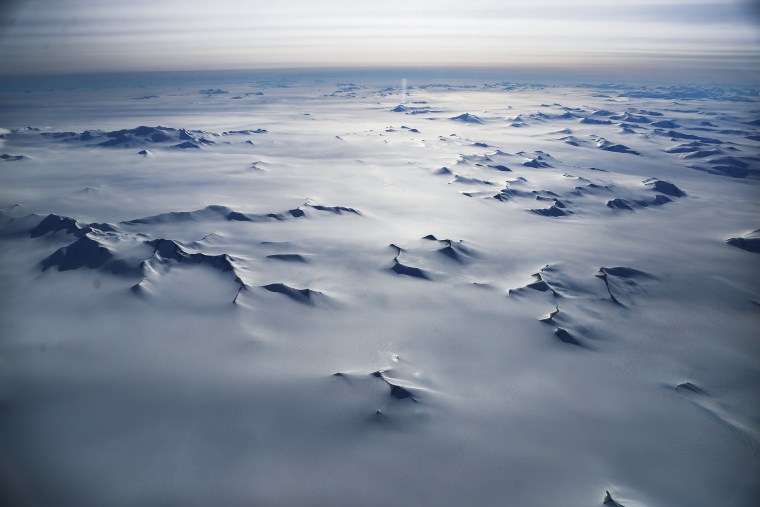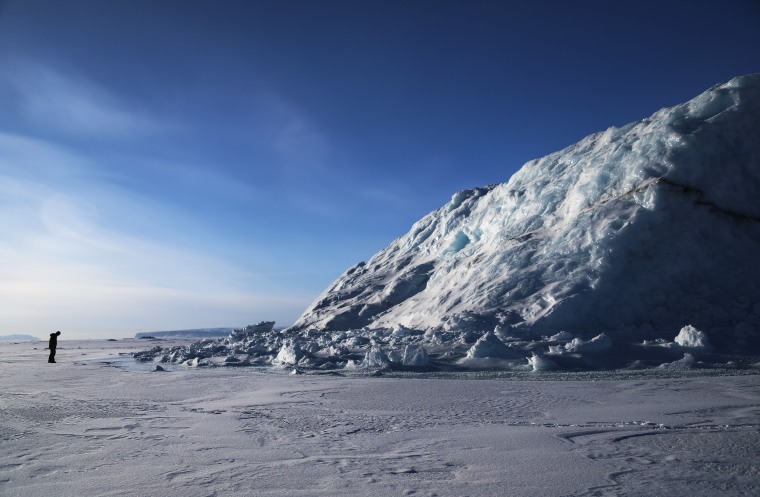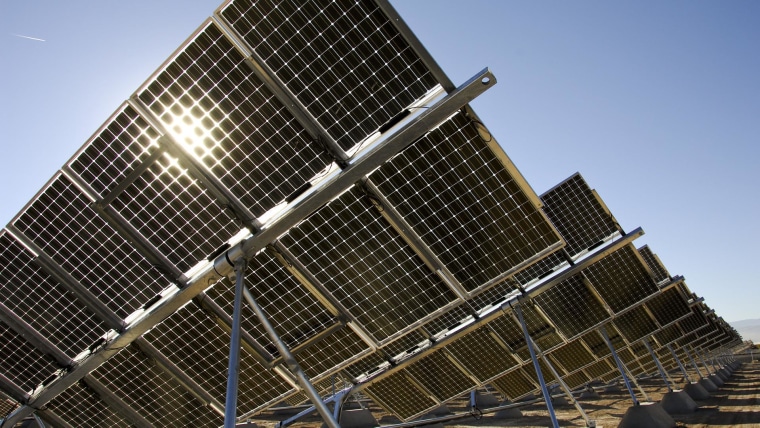Will Glaciers Come Again and if So When
Two audacious plans for saving the earth's water ice sheets
Scientist says behemothic walls and cooling tunnels may be the best ways to salvage polar ice.

For years, scientists have been exploring ways to relieve the vast sheets of water ice covering Greenland and Antarctica, which as the climate warms are melting and falling into the ocean.
They've proposed all sorts of possible fixes, from seeding the atmosphere with sunlight-blocking chemicals to cool the planet to pumping seawater onto the water ice with the promise that it will freeze and furnish lost ice. But these ideas have been widely criticized for their exorbitant cost — thought to be in the hundreds of billions of dollars a yr — and the risks involved.
Now scientists accept come upwards with bold new plans for protecting these massive glaciers — and preventing the potentially devastating rise in sea levels that would occur if they vanished. One involves protecting vulnerable glaciers with underwater walls congenital by robots; the other proposes pumping common cold water through vast tunnels bored under the ice to thicken information technology and proceed information technology from sliding into the sea.
"These geoengineering projects could filibuster much of the polar glaciers from melting into the sea for centuries," says Michael Wolovick, a glaciologist at Princeton University and one of the scientists behind the new proposals. "Other ideas take been proposed, simply the energy costs have been vast. Pumping h2o on tiptop of polar glaciers also runs the chance of the water draining to the bed of the glacier, lubricating it further, and increasing the rate at which it is sliding into the sea."
Implementation of the plans would likely cost tens of billions of dollars. While this is a fraction of the price tag of the other initiatives suggested, wide international cooperation would be needed non simply to fund the projects but to manage them.
Why glaciers matter
Underwater walls and subglacial tunnels sound drastic, but their proponents say they may be the all-time style to forbid pregnant sea level rise as the planet continues to warm. If we do nothing, the oceans are projected to rise more than a meter by 2100. That would pose a grave danger to the 150 million people across the earth living in coastal areas — and could give the global economic system a $50-trillion-per-year hit.
Scientists are especially worried well-nigh sudden glacial loss. That happened in 2002, when a chunk of ice the size of Rhode Island broke off the east declension of the Antarctic Peninsula and crashed into the Larsen Body of water.

Now there's serious concern about Antarctica'due south Thwaites and Pine Island glaciers. Satellite photos show that these vast ice sheets accept been shrinking at a rate of nearly 1 kilometer a year. If they go abroad completely, the resulting floods could swamp low lying regions beyond the globe, with the Pacific and Atlantic coasts of the U.S likely to bear the burden of the flooding.
Building underwater walls
Having dismissed atmospheric seeding and the pumping of sea water onto glaciers, many glaciologists at present believe the all-time way to save glaciers may be to tackle the problem at the source. They suggest constructing enormous walls to forestall warm sea water from eroding the glaciers' body of water-facing edges, which jut out over and float upon the waves.
"In the polar oceans, you have warm salty h2o at depth with colder fresher water on height," Wolovick says. "This warm water is the biggest threat as it causes the base of operations of the floating ice to cook, and the glacier to become unstable. If you could block this water flow, it would reduce the melt rate."
Made more often than not of robot-excavated ocean sediment, the walls would extend from the sea flooring to the base of glaciers' floating ice — holding it in place while shielding it from warm water.
The size of the wall would depend on the glacier in question. For a small one like the Jakobshavn glacier in western Greenland, Wolovick says, a 100-meter-loftier wall extending for about 5 kilometers might suffice. The much larger Thwaites glacier might require a 300-meter-loftier wall extending for 50 or more than kilometers.
Would such walls actually stop the ice from melting? Computer simulations suggest they would. A wall protecting Thwaites glacier, for instance, might enable it to last another 400 centuries. That would purchase us time, allowing people living forth vulnerable coastlines to relocate or to build better ocean walls — and perchance we could use the time to find means to ease global warming.
Cooling hot bedrock
Glaciers lose ice not but at the water's edge but from underneath. That's because glaciers are e'er moving toward the sea over a sparse layer of water just above the underlying boulder. Every bit glaciers motility forth, their lesser surfaces scrape against the bedrock, generating friction and heat and causing some ice to melt. The trouble is that with warming air temperatures causing additional melting, the book of subglacial h2o is becoming larger, and glaciers are being accelerated toward the sea faster than they are being replenished.
Wolovick thinks it might be possible to tinker with the process and meliorate much of the frictional heating by drilling a series of tunnels in the bedrock and pumping cold brine through them.
For the Pino Island glacier, he envisions a series of 5-meter-wide tunnels starting from the nearby Hudson mountain range and extending roughly horizontally in the boulder for 80 kilometers or and so. In one case the alkali starts flowing, he hopes it could freeze some of the water underneath the glacier, slowing the moving water ice in its tracks, and giving the glacier fourth dimension to strengthen and solidify.
A big contend
Wolovick is convinced that glacier geoengineering is our all-time bet for protecting the planet's ice, and he'due south not the only scientist who does.
"This is happening and nosotros can't really close our eyes and forget nigh the fact that nosotros're driving a unsafe mountain road," says Slawek Tulacyzk, a professor of earth scientific discipline at the University of California, Santa Cruz. "We're either going to exist defending the coastline in our own backyard, or nosotros can effort and decrease the risk at the source of the problem, where the ice is beingness discharged to the body of water."
Other scientists disagree, saying that the money needed for the geoengineering schemes would exist better spent on finding means to lower the corporeality of the greenhouse gas carbon dioxide that is being pumped into the atmosphere.
"These approaches are not going to be effective at winning the war considering the root crusade of these changes is warming body of water and air temperatures, and addressing those is what's needed for whatsoever lasting long-term framework," says Twila Moon, a research scientist at the National Snow and Ice Data Center in Boulder, Colorado.
The contend over glacier geoengineering isn't likely to go abroad someday soon. But researchers from China are planning a $3 billion polar enquiry study to evaluate the feasibility of the new proposals over the adjacent decade. So maybe some cold, hard facts volition aid settle the argue.
FOLLOW NBC NEWS MACH ON TWITTER, FACEBOOK, AND INSTAGRAM.

Source: https://www.nbcnews.com/mach/science/can-these-bold-plans-keep-world-s-ice-sheets-melting-ncna877616
0 Response to "Will Glaciers Come Again and if So When"
Postar um comentário